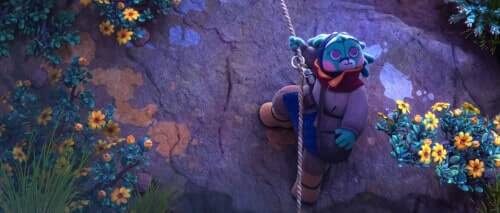Capetonians Nadia Darries and Daniel Clarke co-directed Aau’s Song, the final short film in the second volume of the Star Wars: Visions anthology, now streaming on Disney+.
“A Cape Flats girl and a Bergvliet boy got to make a Star Wars film,” laughs Nadia.
The Lucasfilm anthology celebrates Star Wars through the lens of some of the world’s top animation studios, including Aardman Animation, Cartoon Saloon, Studio LaCachette, Studio Mir and African animation pioneers Triggerfish, who produced Aau’s Song.
Building on the Emmy-nominated first run of Star Wars: Visions in 2021, the second volume currently has a rare 100% critics’ rating on Rotten Tomatoes, where the critics’ consensus says, “Animated with all the vibrancy of a crackling lightsaber, Star Wars: Visions’ second volume is the work of Jedi masters.”
Aau’s Song follows a girl who has a calling to sing but is raised by her loving, stern father to stay quiet because of the calamitous effect her voice has on the crystals in the nearby mines – the kyber that powers lightsabers.
To represent Africa on Star Wars: Visions for the first time, Lucasfilm approached Triggerfish, a 27-year-old studio that was born in Cape Town and also has Kiya and the Kimoja Heroes coming to Disney Junior and the anthology Kizazi Moto: Generation Fire to Disney+ later this year. Triggerfish then turned to Nadia and Daniel, who teamed up with another Capetonian, Julia Smuts Louw of The Smeds and the Smoos fame, to co-write Aau’s Song.
Ranked as “the best episode” of this volume by Screenrant, Aau’s Song has been a hit with critics, hailed as “gorgeous” by everyone from Empire, who called it a “highlight”, to Polygon, who called it “a perfect note to end the season on”.
But Aau’s Song was something of a blind date for the two first-time directors, who had worked together at Triggerfish on the Kidscreen- and Annecy- winner Stick Man, but in different departments.
“We both grew up within five kilometres of Triggerfish but we actually didn’t really know each other before this,” says Nadia, who comes from a performance animation background. “We hadn’t spoken and we were a little intimidated by each other. We came from different cultural backgrounds but funnily enough when we spoke we wanted to tell the same story.“
“We feel very grateful and lucky that our vision aligned so neatly, so quickly,” says Daniel, who’d been a character and production designer in the animation industry, as well as a co-creator on the Kariba graphic novel. “We really discovered the characters through discovering each other. There’s something very Star Wars-y about people from different backgrounds coming together with a shared vision and purpose, and forging lifelong relationships by going on an adventure together.“
While Aau’s Song is universal, it’s also very personal to both Nadia and Daniel. “The relationships between the characters are all based on our personal experiences: Daniel and his grandfather; me and my father, and my relationship with singing,” says Nadia. “Even the Jedi in the film is inspired by my cousin, who is a sangoma.”
Nadia grew up in a conservative Muslim community, where men led the singing as part of their faith. She would sneak out and sing in rock bands. “The voice is just so powerful,” she says. “When I sing, it is my biggest self-healing practice and it reveals so much to me. Something a lot of our cultures in South Africa share is the use of singing and chanting to connect with each other, the land, and spirit. So using the voice as a way to engage with the Force was a natural choice for us as South Africans.”
Dan agrees, adding, “The idea of a poisoned or hurt land that young people could heal with their voices felt very significant to us as South Africans.”
For both Nadia and Dan, it was important that Aau’s father wasn’t a villain. “My relationship with my daddy was warm, but ultimately, I was always living in my father’s world,” says Nadia. “As a parent, you’re supposed to set the rules, and create a safe box for your child to live in. But sometimes your child is just a different shape to your shape.”
She found the ending of Aau’s Song healing. “I didn’t get that ending,” she says. “So it’s cathartic for me. I get to watch it and have that moment that I didn’t have.”
The characters’ distinctive felt textures are inspired by Ndebele dolls, one of a number of South African-inspired touches. “We wanted to evoke the feeling of playing with a toy,” says Daniel. “Felt is a very nostalgic childhood texture for us; it makes you want to reach in and touch it. We also used human voices in the sound design, in the same way that when you’re a kid and playing with toys, you make the sounds with your mouth.“
Aau is voiced by child actor Mpilo Jantjie, with Dineo du Toit handling her singing duties. Also listen out for two-time Oscar nominee Cynthia Erivo as Kratu opposite SAFTA winner Tumisho Masha and Blood Psalms and Flatland star Faith Baloyi. The acclaimed score is by South African electronic music legend Markus Wormstorm, featuring the Cape Town Youth Choir, and Nadia’s own voice too.
“Taking our personal experiences into the Star Wars universe was priceless, and a lot of fun,” says Nadia. “And we both came out of it with a friend for life.”
Watch the Star Wars: Visions Volume 2 trailer:
Image Courtesy: Supplied
